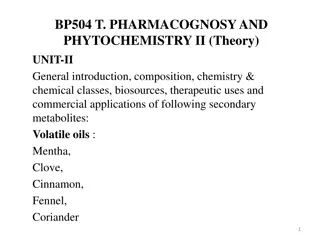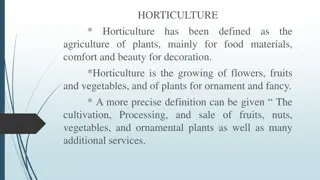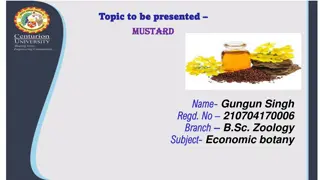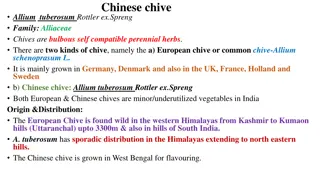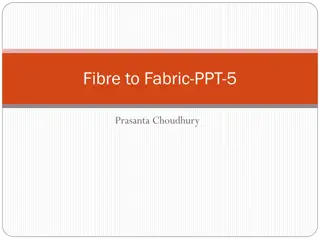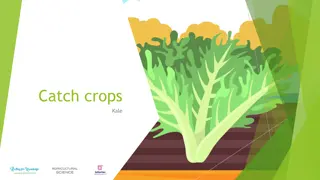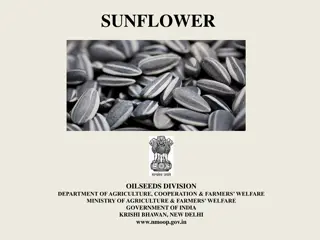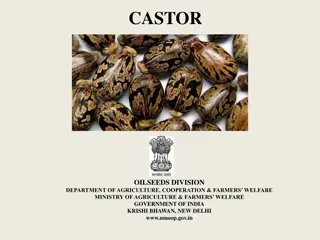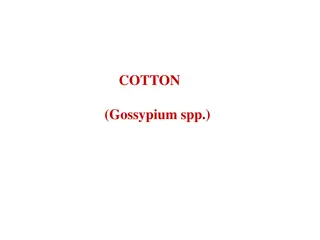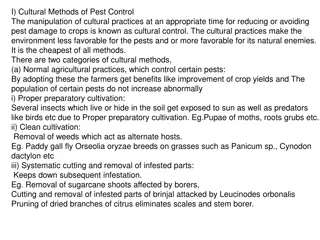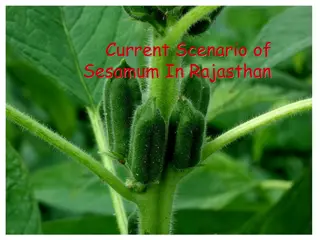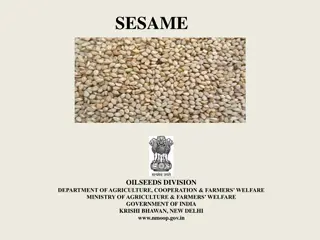The Significance of Jute Cultivation in India's Economy
Jute, a vital commercial fibre crop in India, holds a prominent place in the economy of states like West Bengal, Assam, Bihar, Orissa, and Eastern Uttar Pradesh. It serves as a crucial source of foreign currency earnings and provides employment to millions of farmers and workers. Originating from the Corchorus species, jute is primarily cultivated in West Bengal. The plant, known for its labour-intensive cultivation, plays a pivotal role in rural job creation and socio-economic development. Despite its importance, efforts to enhance jute variety through hybridization have not yielded significant results.
Download Presentation

Please find below an Image/Link to download the presentation.
The content on the website is provided AS IS for your information and personal use only. It may not be sold, licensed, or shared on other websites without obtaining consent from the author.If you encounter any issues during the download, it is possible that the publisher has removed the file from their server.
You are allowed to download the files provided on this website for personal or commercial use, subject to the condition that they are used lawfully. All files are the property of their respective owners.
The content on the website is provided AS IS for your information and personal use only. It may not be sold, licensed, or shared on other websites without obtaining consent from the author.
E N D
Presentation Transcript
JUTE (Corchorus spp.)
Jute is one of the most important commercial fibre crops of India. It plays a key role in the economy of the eastern states of India such as West Bengal, Assam, Bihar, Orissa and Eastern Uttar Pradesh. Raw jute and jute products together are one of the main sources of foreign currency earner for the country. Nearly 4 million small and marginal farmer families are involved in jute farming. Besides, about 2.5 lakh workers are employed in the jute industry and many others in the trade of raw jute as well as jute products. Socio-economic importance of jute cultivation lies in the fact that being highly labour-intensive crop, it ensures job for a sizeable section of rural population.
Area and production of the crop in India In India, most important jute-producing state is the West Bengal, producing more than 75 % of India s total production of over
Origin The jute fibre is available from the bark of 2 cultivated species of the genus Corchorus olitorius (tossa jute), and C. capsularies (white jute) from family Tiliaceae. Africa is considered as the primary centre of origin of olitorius and Indo- Myanmar region as a secondary centre of origin, whereas of capsularies Indo- Myanmar region is considered as centre of origin. There are about 38 recognized wild species of Corchorus but only 9 are available in the Indian sub-continent, though only 2 species are cultivated. Other wild species are also having some characteristics like resistance to pest and diseases, fibre quality etc., which can be incorporated for varietal improvement. But so far no serious attempt has been made in this respect. Though attempts were made to produce inter-specific hybrids, particularly involving 2 cultivated species, apparently there was no success. Attempts for producing hybrid seed also failed and nothing commercially viable could come out.
The plant The jute plant is an annual shrub with basic chromosome number n=7, of family Tiliaceae. Jute fibre is bast fibre obtained from the phloem tissues of the stem. Jute plants have several auxiliary buds for branching, though few non- branching types are available. However, branching is not allowed for commercial purpose by cultural practices. A well grown plant is generally 3-3.6 m tall. A characteristic feature of jute leaves is presence of filiform prolongation of the last pair of marginal teeth at the base of the lamina known as dentawns and margins are serrated, leaf base provided with 2 free lateral stipules with green or red pigment. In vegetative phase lamina is having glossy, smoothness which is lost subsequently. Flowering stage is marked by forking of the stem apex producing for more branches. Inflorescence is extra-auxiliary, generally opposite to a leaf base, cymose, normally having 3 flowers. Corolla are yellow with lighter or deeper shades. Number of sepals or petals are generally 5. Although both the species in respect of most of the morphological characters are similar and sometimes become difficult to identify, there are some important morphological differences as given in the below table.
Morphological differences in two cultivated species of jute C. capsularis C. olitorius Character Seed Chocolate brown color, Dull green/grey black, larger; 1000 seed weight is smaller;1000 seed weight is 2 g 3.3 g Stem Conical, shorter Cylindrical, taller Branch Tends to more branch; Lesser branches; auxiliary buds auxiliary buds may or may present not be present Leaves Smaller; less prominent Larger; filiform appendages filiform appendages develop very prominently develop
C. capsularis C. olitorius Character Flowers Smaller, upper surface of the flower Larger; upper surface of the flower bud bud is flat, duration of flowering is 4 projected into a pointed tip. Flowering weeks period slow extending 8-10 weeks with periodical flush Fruit Globular, 1-1.5 cm in diameter, Elongated, 6-10 cm in length and 0.3-0.8 surface usually wrinkled, loculae 5; 7- cm in diameter; longitudinally ridged, 10 seeds in 2 rows in each locula, loculae 5-6; 25-40 seeds in single row in total seeds being 30-50 in each fruit, each locula, total seed in a fruit being 125- non-dehiscent 200. Usually dehiscent Root Less deeper having more lateral roots. Deeper with less lateral roots. Less water More tolerant to water logging and logging tolerance and developing less produces more adventitious roots. adventitious roots. Root to shoot weight ratio is 1:7 Root to shoot weight ratio is 1:12
Climate Jute, as a fibre crop can be grown in wide range of agro-climatic situation including almost all categories of land and soil. However, most efficient jute- growing areas lies near the South and North of tropics of Cancer (23030 N latitude) and between the longitude of 860 and 920 East with the exception of Brazil which is near equator (1028 -308 South) and also Myanmar which is far away from tropics of Cancer. All these areas are having following common characteristics which are most favorable for jute cultivation. Temperature: mean temperature ranging from 180 to 300 C during growing period. Relative humidity: 70-84 % Rainfall: annual rainfall above 1,500 mm in such a way that main growing months of March, April and May receive at least 250 mm each so that the precipitation is enough to get sufficient moisture for development of young plants and heavier rain during later stages of growth.Water: enough clear water should be available for retting after harvest.
Soil Jute can be grown in all types of lands. In lowland situation, only capsularis can be grown because it can be sown early to escape inundation as well as it can stand water logging at later stages of growth. The olitorius is grown in upland condition. In medium upland both olitorius and capsularis verities can be grown. It can be grown in all types of soils varying from clay to sandy loam but not in very sandy soil or heavy clay soil. In India jute is grown mainly in clayey alluvial soil, whereas in Bangladesh it is almost entirely grown on deltaic alluvium. The capsularis is grown mainly on the alluvial soil near the river banks which are inundated and enriched every year by silt deposit, pH of jute growing soil ranges from slightly acidic to alkaline (5.0-8.6) but neutral or slightly acidic soil pH ranging from 6.6-7.0 is the best. Jute soil should have ample fertility.
Land preparation Since jute cultivation is mostly rainfed, land preparation starts just after the commencement of first rain generally during the end of February. Land is ploughed to open and if time permits exposed to sun for 2-3 weeks which helps killing many weeds and controlling some diseases and also allows decomposition of plant material and debris etc. Since root of jute plant goes more than a foot deep into the soil, deep ploughing is required initially. Subsequently 4-5 cross ploughings are given to transform the soil into a seed-bed of fine tilth. This is required because jute seed is very small and it cannot emerge unless there is fine tilth. For sowing in rows with a seed drill, 1-2 extra ploughings are required to facilitate easy movement of seed drill and uniform emergence. After each plough, laddering is done with a log or bamboo ladder with a man standing on it. This helps in breaking up soil clods, loosening and collecting weeds, leveling the land and slightly compressing the soil. Organic manures are to be applied at the beginning of the land preparation giving sufficient time for their decomposition. Whereas application of basal doses of fertilizer is to be made before final land preparation.
Sowing, sowing dates, sowing season For fibre purpose sowing date varies from place to place depending on the variety, temperature, relative humidity and onset of monsoon. Thus different ecological pockets have different optimum dates of sowing. The factors which determine the sowing dates are: Photosensitivity: jute is a day length sensitive and typical short day plant. Critical day length for the transition from vegetative phase to reproductive phase is 12 hr for capsularis and 12.5 hr for olitorius species. For fibre production, best development of jute can be possible only during that period of the year when day length exceeds critical hours i.e., from March- September in Northern hemisphere for which sowing can be done by the late February at the earliest.
Temperature: low temperature causes pre-mature flowering. Although jute can thrive well in temperature ranging from 270 C and 35.00 C. Sowing date is required to be adjusted in such a way so that temperature below 170C and above 41.50C is avoided and temperature ranging from 270C to 35.00 C is available during the growth period. Rainfall: jute is essentially a rainfed crop grown mainly by marginal farmers rarely providing irrigation at any stage of cultivation right from land preparation. Thus sowing of jute is dependent on the onset of monsoon or pre-monsoon shower or even with the residual moisture in case of flood prone low lying areas. Thus date of sowing may stretch from late February to May. Species and varieties: the capsularis can be sown during March and olitius during April.
Seed rate Quantity of seed required differ in 2 species and also depends on the method of sowing. To get good quality fibre and also economic yield, optimum plant population should be between 4 to 5 lakh plants/ha. Exact quantity of seed required for this population is hardly 1 kg or less. But in practice, considering very small size of seeds, 6-7 times or more seeds are sown to facilitate breaking up of the soil crust by germinating seedlings. This excess seed not only helps assured germination but also suppresses the weed in initial stage. Since many seedlings die at early stages of growth due to lack of moisture and adverse soil and climatic conditions, excess seedlings help to maintain the desired population after thinning out.
Following factors determine the seed rate. Species: the capsularis seed, being larger and heavier than that of olitorius, is required in large quantity; about 60 % higher than olitorius. Method of sowing: in broadcast sowing seed requirement is double of that by sowing in rows. To ensure uniform coverage, broadcasting is done crosswise. Thus requirement of seed in broadcast fields ranges from 7.5 to 10 kg/ha in case of capsularis and 4.5 6 kg/ha in case of olitorius. In case of sowing in rows 30 cm apart and an intra-row spacing of 1 cm only 3-5 kg/ha seed is required.
Nutrient management Application of organic manure and fertilizer is essential for getting good yield. The quantity required varies depending on the variety, soil type and cropping pattern etc. for medium and upland, FYM @ 7-10 tonnes/ha is required. Nitrogen increases the vegetative growth and thereby fibre yield, phosphorus prevents lodging, improves fibre quality and increases the efficiency of nitrogen utilization. Potash as well as sulphur are useful for reducing the incidence of disease. Magnesium also increases the yield and same is done by boron on deficient soils of north Bengal and Assam etc. The olitorius are more efficient in nutrient utilization, thus requiring less fertilizer than capsularis. Optimum requirement of fertilizer has been worked out as N40 P20 K20 for olitorius and N60 P30 K30 for capsularis jute. Nitrogen is to be applied in 2 split doses one at sowing and another during 3 to 4 weeks of plant growth after the first thinning and weeding. P and K should be applied as single basal dose during sowing.
Weed management Intercultural practices are required for weeding and thinning of the crop as well as to promote the tilth and aeration of soil. Since seed rate is higher than the actual requirement of plant population, thinning is essential to acquire optimum population. Generally 2 thinnings are required, one during 3 to 4 weeks after sowing followed by next one after 5-6 weeks after sowing. Weeding is also done simultaneously. Final thinning is done to maintain the spacing of about 10 cm among the plants in case of broadcast sown crop and around 5-7 cm between plants within row and 25-30 cm between rows allowing about 4-5 lakh population. First manual weeding is done at 3-4 weeks stage and the next at 8 weeks stage of the crop. Following are the weedicides which, in combination with manual weeding can effectively check the weed problem. Tetrapion (TFT-Na) @ 2-4 kg/ha as pre-plant or Fluchloralin @ 1-2 kg/ha as pre-plant or pre- emergence or MSMA @ 4-5 kg/ha or Dalapon @ 6 kg/ha as post emergent directed application at 3 weeks age of crop.
Water management Although jute is rainfed crop, to assure timely and early sowing in case of late north-western or pre- monsoon rain one pre-sowing irrigation is highly beneficial. One more irrigation may be required after sowing during the period between germination and outbreak of monsoon for sustaining growth of young seedlings when soil moisture goes below 20 %.
Harvesting Jute can be harvested at any time after 90 days until 50 % pod or fruit set. Time of harvest is determined by a number of factors as given below. Land situation: lowlands where capsularis is grown are often subject to prolonged floods, which may cause destruction of a crop. To avoid this, the crop is harvested early in 100 days or even earlier. Cropping system: when jute- rice rotation is followed, jute has to be harvested in 90-100 days to facilitate land preparation etc. for timely transplanting of autumn rice.
Harvest for higher yield: yield is very low in early harvest and quite high in 140-150 days crop during early pod stage. Differences in yield among pre-bud, bud and flowering stage of the crop are substantial. Harvest for better quality: quality of the fibre at 90-100 days harvest during pre-bud and bud stage is the best which gradually declines as harvesting is delayed and becomes very poor after early pod stage at 140 days and onwards. Considering all these factors, harvesting at 120-130 days has been found as the best compromise between quality and quantity.
Ribboning Ribboning, though not in use in main jute growing countries like India and Bangladesh, is very common in China and Taiwan. In this method, raw bark is peeled out from the green plant immediately after harvest and the bundles of ribbons thus obtained are retted. There are several methods of ribboning using bamboo pole, bamboo hook and bicycle hub etc. Decorticating machine developed at CRIJAF is also very useful in machine ribboning. Ribboning has following advantages: Weight to be transported to the retting tank from field to nearly one third. Very little quantity of water is required. Washing of the retted fibre is easier. Very suitable for control retting by bio-chemical or microbial means. Time of retting is reduced by 3-7 days. Completely root-free fibre are obtained. But major disadvantages of the ribbon retting is that ribbon retted fibres are of inferior quality than the whole plant retting. Ribboning is costly and also requires additional labour.
Retting For retting of jute stem slow moving clear water is the best for getting best quality fibre. However, in practice retting is done in pond, canals, roadside ditches or any other water body available. In some flood prone areas it is done even in the same flooded field where the crop has been grown. For retting purpose steeping is done in a raft or float locally called as jak which is formed by arranging serially the bundles of jute plant. Bundles are arranged on the jak in 2-3 layers, if water depth is sufficient. As a general rule, water should be of the ratio of 1:20 by volume. Under certain conditions retting is possible with 1:10 or 1:5 ratio also which, however, delays the retting process. Depth of water should be at least 1.9 m. bottom of the jak must not touch the bottom of the water body. Arrangement of the bundles is made in such a way that apical portion of the plant in first layer lies under the basal portion of the plant of second layer.
Jak is then covered by some covering materials such as weeds, grasses, water hyacinth and rice straw etc. have to be placed on the jak to submerge it at least 10-20 cm below the water surface. Covering material or weight must be tannin and iron free, so that the color of the fibres does not become dark. Few plants of Sesbania aculeata or Crotolaria juncea etc. are also added to the jak which act as activator for hastening the retting. There are chemical activators also like sulphate or phosphate of NH4, K, Ca or Mg. Retting is a complicated phenomenon in which microbial processes by the activities of anaerobic and aerobic bacteria and fungi as well as biochemical process by the activities of different enzymes takes place. These activities ultimately loosen the fibres from the woody core of the stem by decomposing and dissolving the pectin, hemicelluloses and other cementing agents. Depending on the situations, retting process completes in 8- 30 days.
Following are the factors which determine the time taken for retting. Variety: Capsularis take shorter time for retting. Temperature: water temperature above or below optimum (340C) prolongs retting. Retting completes in 10 days in diurnal variation of temperature between 30 and 370 C and may even take 7 days in continuous temperature of 340 C. Age of the crop: Stems having more age take longer time for retting. Condition of water: retting is delayed if volume or depth of water is less than the optimum requirement and retting is fastest in lower pH. Water temperature below or above 340 C delays retting. Fertilizer: crop receiving higher dose of nitrogen rets faster while high phosphorus causes delay in retting. After 8-10 days or around that period, daily careful examination is required to find whether retting process is completed or not. When bark can be easily extracted from the woody portion of the stem and the clean fibres are easily available after washing the extracted bark, the process of retting considered to be completed. This is done purely on the basis of the experience. It should be immediately removed from the water and fibre should be extracted without further delay to avoid over retting. Strength of the fibre is severely reduced in case of over retting.
Chemical retting of jute ribbon is also possible by using 0.5 % solution of ammonium oxalate with water in 1:10 ratio at 80-850 C temperature giving, however rough but strong fibre. Nowadays low heat chemical process is claimed to have been developed giving exceptionally superior quality fibres, but high capital outlay for such plant is prohibitive.
Extraction Fibre extraction is done manually by hand. It may be by single reed method in which case one plant is taken out from the bundle, fibre stripped out from the stick at first in the 8-10 cm basal portion then the rest of the portion by pulling; 4-5 reeds also can be taken out at a time and extracted this way. In another method known as beat-break-jerk method, the entire bundle or a part of it is taken and then breaking and twisting the middle portion, fibres are grabbed and vigorously jerked until all the fibres free from the stick. After the fibre is extracted, it is washed thoroughly, dried in mild sun for several days over a bamboo frame and baled for marketing.
Pest management Yellow mite (Polyphagotersonemus latus) Stem weevil (Apion corchori) Jute semilooper (Anomis sabulifera) Bihar hairy caterpillar (Spilosoma obliqua) Management: Resistant varieties: JRO 524, JRC 321 and JRO 36E Integrated pest management Disease management Seedling blight, collar rot, stem rot and root rot Management: cultural practices, proper drainage, crop rotation. Seed treatment with Agrosan GN, Ceresan or Dithane M 45 @ 4-5 kg/ha seed and spraying of Dithane M 45, Copper oxychloride, Bavistin, Carbendizim etc. @ 0.75 0.15 %.
Cropping systems Jute-rice, jute-rice-cabbage, jute-rice-potato Varieties C. olitorius: JRO 632, JRO 524, JRO 878, KOM 62 C. capsularis: JRC 212, JRC 321, UPC 94, KTC 1, JRC 4444, KC 1, Hybrid C
List of References Science of Crop Production By Gururaj Hunsigi and K.R. Krishna. Sugarcane Production Technology _ By Gururaj Hunsigi. Sugarcane- By Sundra. Cotton Monograph By Dastur et. al. Hybrid Cotton in India By Mukund Joshi. Field Crop Production By Rajendra Prasad et al. Modern Techniques of raising Field Crops- By Chadda singh et al. Hand Book of Agriculture By ICAR (2006) Principles of Crop Production By SS Singh. Priniples of Crop Production By Palaniappan & Balasubramanyam. Agronomy of Field Crops- By S.R. Reddy


